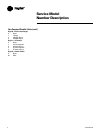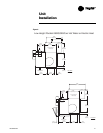
16
VAV-SVN01E-EN
Unit
Information
Single-Duct Units
The basic unit consists of a sheet metal
casing with an air valve, which is used
to modulate the air being delivered into
the occupied zone. The unit is designed
to modulate either cooling or heating
air between the temperatures of 40°F
and 140°F. Air enters the air valve
through the round or rectangular inlet
and exits into the sheet metal casing to
be distributed to the zone either
through integral round outlets in the
casing or through rectangular duct
attached to the discharge of the unit.
The basic unit can also be ordered with
factory-mounted electric or hot water
heating coils attached to the discharge.
(See Figure 1.)
These re-heat units are used primarily
to reheat air-to-zone temperature when
the load in the occupied space is low.
Primary air is modulated through the
VariTrane air valve by rotating the
damper blade. All air valves have a
round/rectangular inlet for easy fit-up
with incoming ductwork.
Figure 1 – Typical Single-Duct Units
Dual-Duct Units
Dual-duct units provide two air valves:
one as heating primary air and the
other as cooling primary air. Both
discharge into the common outlet,
which leads to the zone being con-
trolled. (See Figure 2.)
The units are provided with a slip and
drive rectangular duct connection or
can be ordered with integral outlet
plenum.
Sequencing of the hot and cold air
valve is dependent upon job
requirements. One typical control is the
valves working in conjunction with each
other to respond to zone temperature.
When the cooling valve becomes fully
closed or reaches a specified minimum,
then the heating valve will begin to
modulate or vice versa. The typical
result is that air flowing to the zone
varies from the maximum down to a
minimum and back up to a maximum
as the load varies and as the controls
would cause one air valve to close and
the other to open.
Another typical application is when the
unit provides a constant volume to the
zone. When the zone sensor is tied
directly to the heating valve, it will
modulate the heating valve according
to the zone temperature.
When the heating valve is fully closed
or there is a call for cooling in the zone,
the cooling valve will be at constant
supply. As the space becomes too cool,
the heating valve will modulate open,
decreasing the cooling valve flow. The
typical result is that the air flowing into
the zone stays at a constant flow
whether the unit is heating or cooling.
Figure 2 – Typical Dual-Duct Unit
VCCF
VCEF
VCWF
VDDF


















